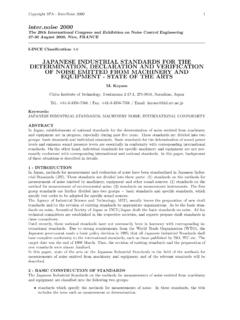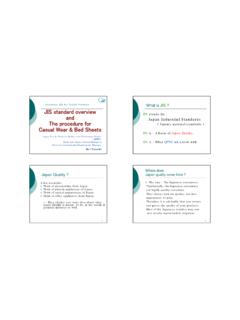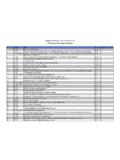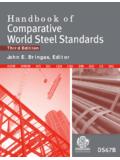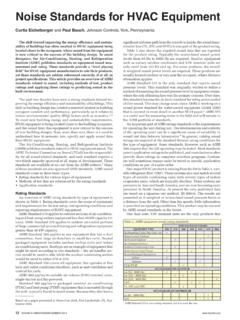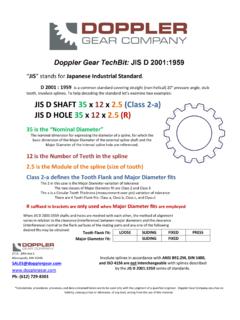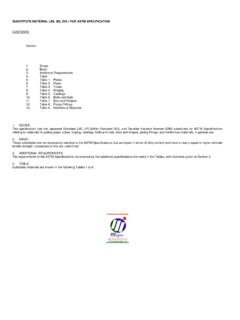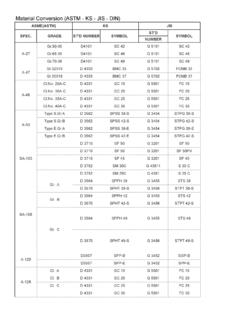Transcription of Japanese desiccator method JIS A 5905 - LabCheck
1 35 Ngaio Street New Plymouth NEW ZEALAND Ph: +64 6 7553337E-mail: web: 2002 Stephen Young & Associates LimitedStephen Young & Associates LimitedCompare your laboratory withothers around the & mechanical woodproduct testingPage 1 SUMMARYI nter-laboratory trials were used to quantify between-laboratory differences for the Japanese desiccator formaldehyde emission differences in equipment and methodology were determined by visiting a number of laboratories. The visits were followed bylaboratory trials to ascertain the significant this knowledge, further inter and intra-laboratory trials were conducted to determine if differences could be are made for future changes to the desiccator method JIS A 5905A study into the factors causing inter-laboratory differencesIntroductionThere are three Japanese standards documenting formaldehydeemission testing by the Japanese desiccator method .
2 JapaneseIndustrial standards (JIS) A 5905 and A 5908 cover testing of fi-breboard and particleboard. The Japanese Agricultural Standard1515 covers plywood testing. This report is based on data frommedium density fibreboard (MDF), to 18mm thicknesses,of between 700 and 800 kg/m3 made using urea formaldehyde(UF) objective of this work was to improve the repeatability andreproducibility of the Japanese desiccator method and to makerecommendations to the JANS (Japan, Australia, New ZealandStandards) Committee. Other researchers have carried out fun-damental work examining the factors affecting formaldehyde emis-sion (Roffael, 1993). However the objective of this work was notto carry out fundamental studies but to ascertain the significanceof specific differences in equipment and methodology using a spe-cific product, namely MDF made with current UF three Japanese desiccator standards are similar, employinga glass desiccator as a test chamber.
3 Test-pieces are cut intorectangles150mm by 50mm. A number of test-pieces, correspond-ing to approximately 1800cm2 total surface area, are supportedabove a crystallising dish containing water inside the lid is placed on the desiccator and the samples are sealedinside for 24 hours at 20 1 C. The emitted formaldehyde is ab-sorbed by the water in the crystallising dish in proportion to theemission rate from the sample. The concentration of formalde-hyde in the water is determined by reaction with acetylacetone,followed by spectrophotometric determination of the trials were conducted to ascertain the actualdifferences between around the Pacific Rim were contacted and inmany cases visited to ascertain the differences in equipmentand methodology used in each in methodology and equipment were simulatedin laboratory trials.
4 This information in combination with lit-erature searches was used to determine the most and between laboratory trials were then conductedspecifying the test procedure exactly based on these were made to the JANS standards trialsFour inter-laboratory trials were conducted, the results of one ofthese is presented here. The laboratories included commercialtesting laboratories, Government laboratories and factory labora-tories from Australia, New Zealand and Asia including Japan. Thetrials used samples of and MDF, UF resin. Sam-ples for five formaldehyde tests were randomised and sent to theparticipating laboratories. One set of samples was flown to Sin-gapore and back to New Zealand to test the effect of flying sam-ples to different locations.
5 The results indicated little or no effectfrom flying samples to Singapore but showed a wide range of val-ues from the different laboratories. The difference between thelowest and the highest value was mg/lOver the past two years, Pacific Rim manufacturers of Panelboardshave been producing increasingly lower formaldehyde emittingproducts. Product made in, or exported to, Asia, New Zealandand Australia is often tested by the Japanese desiccator methodto determine its emission category. The emission ratings for thetest are, according to JIS A 5905: E0 for < , E1 for < and E2 for <5mg/l. As with the perforator method EN120, thisrating determines the end use of the product and in many casesthe buyer specifies the emission rating in the purchase produce low emission values whilst still maintaining mechani-cal test qualities the manufacturers must use different and in somecases more expensive technology.
6 There is considerable com-petition to produce low emission product and some scrutiny bothby other manufacturers and by the purchaser to ensure that prod-uct truly conforms to specification. As the demand for low emis-sion product has increased it has become apparent that differentlaboratories have been rating product differently. Different labo-ratories can rate a single product E0, E1 or E2. This has led toproblems with sale of product, loss of potential markets and insome instances has led to lack of confidence by the manufactur-ers in the test method and in the laboratories performing the investigate and rectify this problem, TimberTest conducted JE TTTDEFGHIJKL aboratoryEmission (mg/l)Figure 2: Inter-laboratory trial.
7 Limit bars are the 95%confidence limits for the mean of five 1: The Japanesedesiccator test equipment. 2002 Stephen Young & Associates LimitedStephen Young & Associates Limited35 Ngaio Street New Plymouth NEW ZEALAND Ph: +64 6 7553337E-mail: web: your laboratory withothers around the & mechanical woodproduct testingPage mg/l0246810121416 Days after cuttingLaboratory visitsBetween June 1998 and April 1999 12 companies in the Pacificregion were contacted or visited. The objective was to determinethe differences in the interpretation of the standard, which couldbe leading to the wide range of results, found in the inter-labora-tory number of differences were found in sample handling, test equip-ment and methodology.
8 These differences are summarised be-low:Pre-conditioningSamples were cut and then pre-conditioned for between zero and10 days. The pre-conditioning environment varied with some be-ing controlled at 65%RH and 20 C while others used uncontrolledlaboratories for pre-conditioning. In the later cases the room tem-peratures ranged from 18 to 30 C (temperate to tropical situa-tions).Laboratories pre-conditioned samples either in plastic bags,stacked together without separation or in racks which ensuredseparation. The racked samples were exposed to either still ormoving air (fans).Background Formaldehyde in the Pre-Conditioning Environ-mentAlthough it could not be quantified it was suspected that the back-ground formaldehyde in the pre-conditioning environment differedbetween laboratories.
9 Samples were conditioned in a range ofenclosed cabinets or rooms, some of which had clean air and someairflow from the manufacturing facilities. Some laboratories con-ditioned the samples inside plastic of Test-piecesWhen asked to test one product laboratories made different deci-sions on how many test pieces to test. Some chose less than1800cm2, others chose more than PlatesPlates of various designs were used to support the sample abovethe crystallising dish. The most common plate types were thosesupplied by desiccator Clamps and RacksClamps and racks were also used to keep thin samples upright inthe desiccator . These systems included stainless steel wire bas-kets and carousel arrangements from which the samples wherehung using alligator clips.
10 Some laboratories used staples to at-tach the samples together which held the samples range of desiccator designs were in use. These included Japa-nese manufactured desiccator s with convex bottoms, Germandesigns with flat bottoms and a range of different enclosed vol-umes. The distance between the sample and the top of the crys-tallising dish varied with each DishThe formaldehyde is collected into water in a crystallising dishes ranged from 110mm to 120mm inside of TestAll the laboratories attempted to maintain test temperature be-tween 19 C and 21 C as specified in the standard. Some labora-tories did not log the temperature throughout the test and weretherefore not able to determine if the temperature remained withinthe limits.
